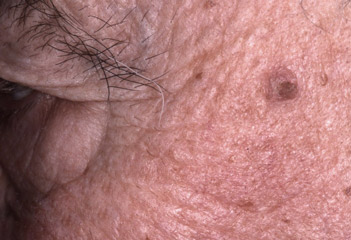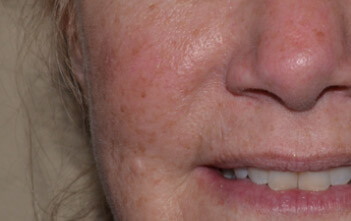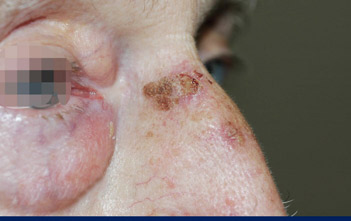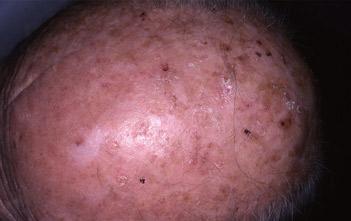
Sun exposes your skin to
the risk of Actinic Keratosis.
To find out more about Actinic Keratosis, follow this sunbeam.
What is
Actinic Keratosis?
Actinic Keratosis, also called solar keratosis, is a pre-cancerous chronic skin condition linked to over-exposure to the sun. The UV rays from the sun cause damages to the surface of the skin, particularly in the DNA of keratinocytes. These damages can induce mutations in the DNA of these cells, sometimes leading to their abnormal and uncontrolled proliferation causing the appearance of Actinic Keratosis.
KER'INFO
Actinic Keratosis is more common in sunnier countries with fair skin population: in Australia, it affects one in every two people of Caucasian origin over the age of 40. (4)
What does Actinic
Keratosis look like?
Actinic Keratosis lesions look like small blemishes, scabs or spots that may appear gradually. They are very dry, rough (they feel like sandpaper to touch) and varied in terms of shape and colour (sometimes red and/or brown)
At the more advanced stage, the lesions can become ulcerated and swollen, and begin to bleed or weep.



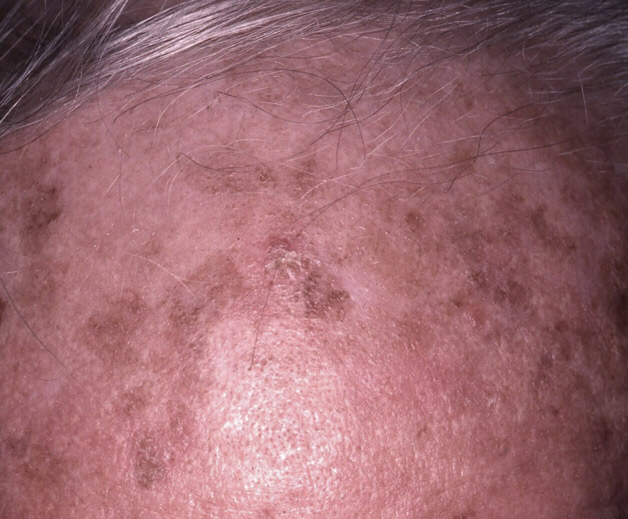
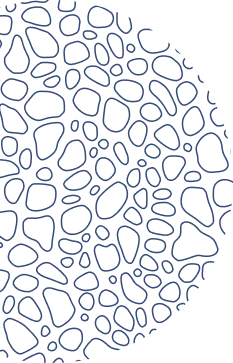

KER'INFO
Global prevalence of Actinic Keratosis has dramatically increased in recent decades. (5)
Clearly visible lesions... And hidden damage too!
Actinic keratosis lesions can be visible at the surface of the skin or hidden under the skin surface but always in the sun-damaged area. Together, visible and non-visible lesions are the field cancerization. Therefore, they can develop into invasive carcinoma, that means they can go through the deeper layers of the skin and reach the blood vessels.
Actinic keratosis are precancerous lesions that can regress or stay at the early stage of in situ carcinoma (visible or not) or can develop into invasive carcinoma. (6-7)

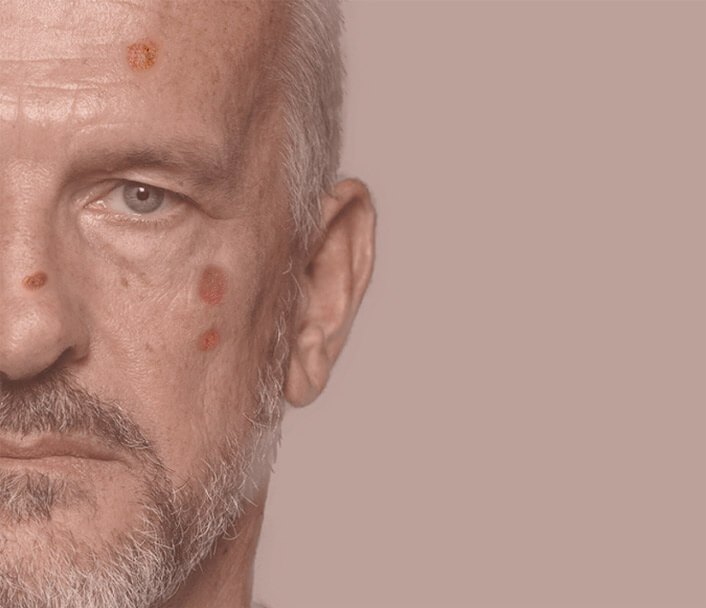

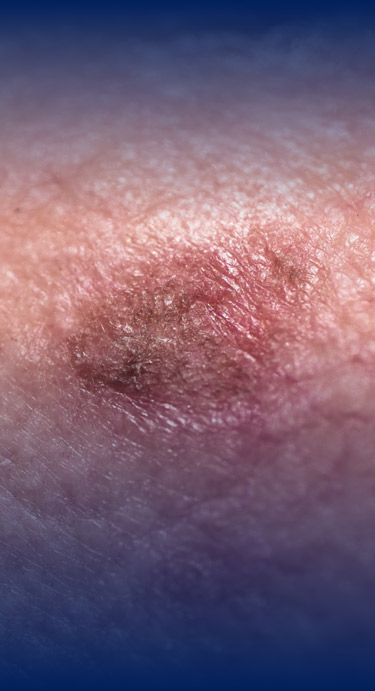
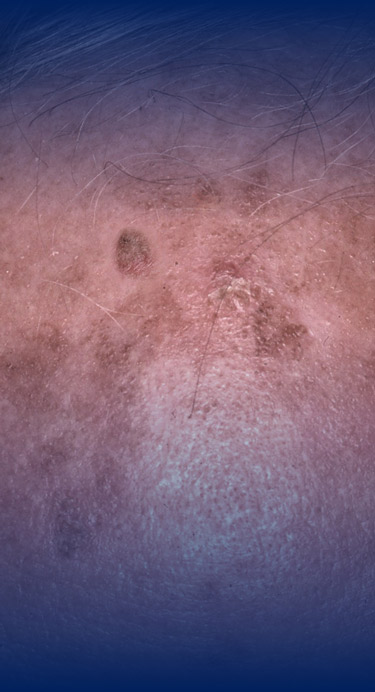
GRADE I*
Early in situ squamous cell carcinoma type AK I
(mild Actinic Keratosis)
*According to the ROWERT-HUBER histological classification(1)
GRADE II*
Early in situ squamous cell carcinoma type AK II
(moderate Actinic Keratosis)
*According to the ROWERT-HUBER histological classification(1)
GRADE III*
In situ squamous cell carcinoma type AK III
(severe Actinic Keratosis)
*According to the ROWERT-HUBER histological classification(1)
Invasive squamous
cell carcinoma
Invasive squamous
cell carcinoma
When Actinic Keratosis develops into invasive squamous cell carcinoma
There is a risk, albeit a small one, of Actinic Keratosis developing into invasive squamous cell carcinoma (non-melanoma skin cancer).
Actinic Keratosis accounts for 65% of invasive squamous cell carcinomas. The risk of developing this form of carcinoma can therefore be considerably reduced by treating any Actinic Keratosis lesions.(8)

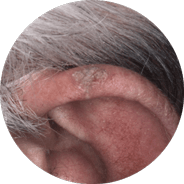
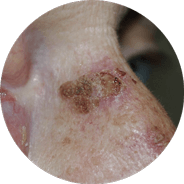
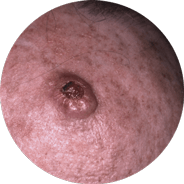
can turn directly into invasive squamous cell carcinoma.(9)
For illustration only
Note: Some lesions cannot be seen with the naked eye. There is no clearly established correlation between visible lesions and what is happening beneath the skin.
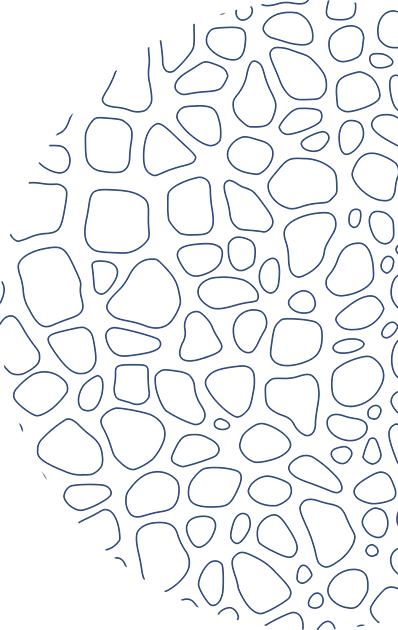

The sun has benefits.
Sunlight has a positive effect on our bodies, mainly by triggering the synthesis of vitamin D in our skin.
Exposure to the sun for at least 5–15 minutes twice a week during the early afternoon is usually enough for the body to produce vitamin D.
But UV rays are harmful.
In high doses, the sun becomes the arch enemy of our skin.
The most common problem is sunburn, which can vary in severity depending on phototype and degree of exposure. Repeated over-exposure also speeds up the skin aging process (premature wrinkles, blemishes, etc.).
These effects of the sun on the skin are mainly related to ultraviolet rays. In the long term, they can damage the DNA of cells and induce the development of skin cancer.
Simple ways to protect your skin
Fortunately, there are lots of ways to keep well protected from the sun.
Avoid exposure
between 11am
and 4pm
Wear long sleeves,
pants or skirts, a hat,
and sunglasses.
Apply sunscreen 20 minutes before going out, then every 2 hours to all exposed areas, not forgetting your ears, hands, and neckline.
Use sunscreen with a high sun protection factor that is waterproof and contains photostable ingredients.
KER'INFO
Find the best texture and formulation of sunscreen for your targeted skin area.
Actinic Keratosis is more common in certain situations. (2)
Sun is the leading cause of Actinic Keratosis, but not everyone is equally at risk under the sun. Skin type is also an important factor : each person’s skin is unique, with its own color and sensitivity to the sun : This is known as the phototype.
Some outdoor occupations and activities involve greater exposure to the sun than normal, which increases the risk of Actinic Keratosis and skin cancer.
Chronic over-exposure to strong UV light
Fair skin - phototypes I and II
Older age
Compromised immune system
Men
KER'INFO
The UV Index explains how harmful the sun’s UV radiation is at any given time and place.
Different types of skin phototypes. (11)
Discover the different skin types and the different risks associated with sun exposure. What about you? What is your skin type?
KER'INFO
The sun is a key factor in the onset of Actinic Keratosis, and fair-skinned people are more likely to be affected because they have less natural protection.

Discover your
potential risk
of developing Actinic Keratosis(2)
This questionnaire can provide you an indication of the potential risk of developing Actinic Keratosis, based on risk factors determined using epidemiological data.
Warning : This questionnaire is not for clinical or diagnostic use.
Question 1 / 8
What is your skin type?
Question 2 / 8
How old are you?
Question 3 / 8
Are you...
Question 4 / 8
Are you taking chronic immunosuppressant treatment?
Question 5 / 8
Do/did you work more than 6 hours per day outside?
Question 6 / 8
Do/Did you have frequently recreational outdoor activities (i.e more than 90 days per year)?
Question 7 / 8
Did/do you use sun protection (hat, clothing, sunscreen)?
Question 8 / 8
Do you stay out of the sun or avoid going outside when the sun is at its strongest?
The risk seems high
Your skin is very sensitive to the sun and you are particularly at risk of developing Actinic Keratosis. Avoid going out in the sun, especially between midday and 4pm When in the sun, make sure you use a high level of protection : long sleeves, long pants or skirt, a wide-brimmed hat, and sunglasses with a UV filter.
Keep an eye on your skin and check it regularly for any blemishes, wounds, or lesions, especially on your head, neck, ears, nose, chest, shoulders and upper back, hands, and forearms. If you spot anything, see your doctor or dermatologist.
The risk seems medium
Although you are not at high risk of developing Actinic Keratosis, you still need to take care of your skin in the sun.
To minimize the risk of getting Actinic Keratosis and skin cancer, it is important to protect yourself from the harmful effects of the sun. If you have skin type I–IV, make sure you wear suitable clothing (including hat and sunglasses), whenever you are outside and in the sun, apply a sunscreen with a high protection factor to all exposed areas of skin, and stay in the shade.
If you spot any suspicious blemish, scab, or other change to your skin, make an appointment with your doctor or dermatologist.
The risk seems low
Although you are not at high risk of developing Actinic Keratosis, you still need to take care of your skin in the sun.
To minimize the risk of getting Actinic Keratosis and skin cancer, it is important to protect yourself from the harmful effects of the sun. If you have skin type I–IV, make sure you wear suitable clothing (including hat and sunglasses), whenever you are outside and in the sun, apply a sunscreen with a high protection factor to all exposed areas of skin, and stay in the shade.
If you spot any suspicious blemish, scab, or other change to your skin, make an appointment with your doctor or dermatologist.
The risk seems very low
Although you are not at high risk of developing Actinic Keratosis, you still need to take care of your skin in the sun.
To minimize the risk of getting Actinic Keratosis and skin cancer, it is important to protect yourself from the harmful effects of the sun. If you have skin type I–IV, make sure you wear suitable clothing (including hat and sunglasses), whenever you are outside and in the sun, apply a sunscreen with a high protection factor to all exposed areas of skin, and stay in the shade.
If you spot any suspicious blemish, scab, or other change to your skin, make an appointment with your doctor or dermatologist.
If Actinic Keratosis appears,
treatments exist. (12)
If Actinic Keratosis appears,
treatments exist. (12)

Freezing
CRYOTHERAPY

Surgical therapy

Light
therapy
PHOTODYNAMIC THERAPY

Topical
treatments
CREAMS, GELS, AND OINTMENTS
These treatments can target several lesions at once and can be applied to the whole field cancerization.
KER'INFO
Discussion between patient and doctor is crucial to ensure a correct understanding of the condition and the treatment.
Advice from an expert
Prof. Eggert Stockfleth, Dermatologist and Head of the ESCF (European Skin Cancer Foundation) talks about the condition.
For more information
The ESCF (European Skin Cancer Foundation) works to develop and provide standardized prevention strategies and treatment guidelines at European level, thereby helping to improve the treatment of skin cancer and promote best treatment practices through training and the sharing of knowledge.
Take care of your skin
and if in any doubt,
please consult a specialist.


At Pierre Fabre, we take care of people as a whole, in all their diversity. From health to beauty, we have adopted a unique approach that allows us to make a positive contribution to the overall well-being of individuals. This complementarity is a key element of our global skin cancer program, United Against Skin Cancers.
Our expertise in dermatology, combined with our knowledge of oncology, puts us in a unique position for fighting skin cancer from multiple angles. United Against Skin Cancers brings together numerous global initiatives inspired and developed by Pierre Fabre around our three core values of care: prevent, treat, and support.


Pierre Fabre is engaged for decades in fighting skin diseases, inclunding skin cancer and actinic keratosis.
The awareness campaign AK IS NOT OK! has been created by Pierre Fabre to make this disease better known by the general population in order to encourage the early diagnosis of Actinic Keratosis. Treated early, the risk of developing a non-melanoma skin cancer can be considerably reduced.
To be sure not to miss any communication on Actinic Keratosis, follow Pierre Fabre on:
a medicine made by Laboratoires Pierre Fabre ?
